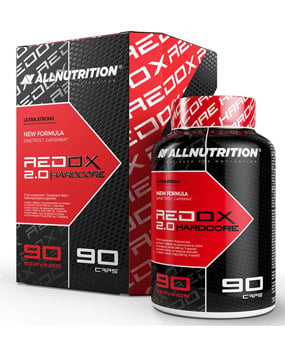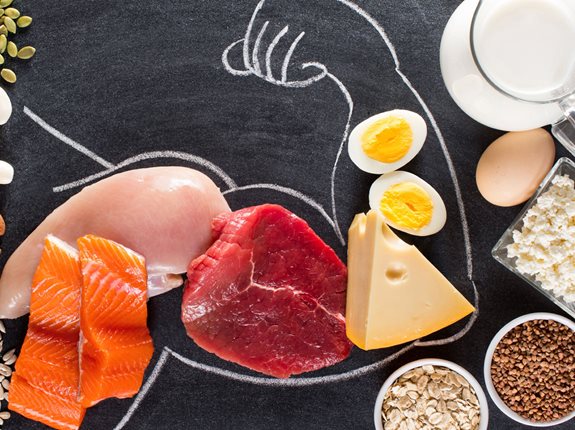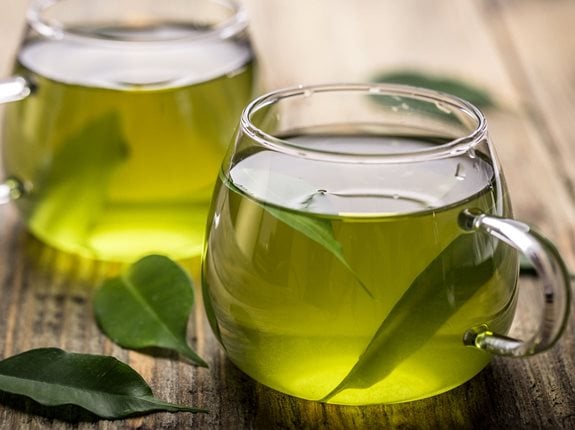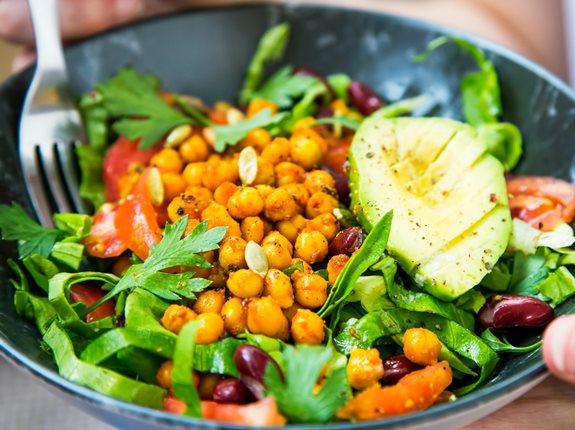β-Alanina jest składnikiem dwupeptydu karnozyny (β-alanylo-L-histydyny), której biosynteza uzależniona jest od dostępności β-alaniny jako substratu. Karnozyna buforuje spadek pH związany m.in. z powstawaniem kwasu mlekowego w mięśniach w trakcie wysiłku. Z tego względu przyjmowanie β-alaniny zmniejsza zmęczenie fizyczne.
Naturalne źródła Beta Alaniny to czerwone i białe mięsa takie jak kurczak lub wołowina.
Do najbardziej znaczących efektów przy suplementacji Beta Alaniną możemy zaliczyć:
- Wzrost całkowitej wydolności anaerobowej podczas treningu. Możemy dokonać wysiłku fizycznego z większą
intensywnością i w dłuższym czasie.
- Opóźnienie uczucia zmęczenia. Dzięki czemu możemy utrzymywać wyższy poziom intensywności podczas treningu.
- W połączeniu z monohydratem kreatyny, znaczny wzrost beztłuszczowej masy mięśniowej.
Interesujący jest wpływ suplementacji Beta Alaniną na poziom Karnozyny, oraz wiązania peptydowe, które możemy znaleźć w mięśniach i mózgu, a konkretnie w komórkach. Wzrost poziomu karnozyny w organizmie prowadzi do szeregu ulepszeń fizjologicznych w mięśniach, które mają bezpośredni wpływ na możliwość zwiększenia intensywności
ćwiczeń. Odpowiedni poziom Beta Alaniny jest czynnikiem wpływającym na syntezę karnozyny więcj eśli nie uda nam się utrzymać odpowiedniego poziomu Beta Alaniny, synteza karnozyny jest również ograniczona!
Podstawowe działanie Karnozyny (szczególnie w komórce), może pozwolić nam na:
- lepsze wyniki w krótkoterminowym wysiłku o wysokiej intensywności,
- poprawę kurczliwość mięśni,
- zwiększenie długości i intensywności treningu.
Karozyna jest przeważnie lokalizowana w włóknach mięśniowych typu IIa najbardziej we włóknach określanych mianem IIb - szybkokurczliwych. Karnozyna jest również magazynowana w włóknach mięśniowych typu I ( wolnokurczliwych ) ale w mniejszych ilościach.
Karozyna osiąga duży poziom w mięśniach wystawionych na ćwiczenia i o obniżonym pH.
Fizjologiczne pH mięśni wynosi ok. 6.8, karozyna posiada właściwości podnoszące H+ i zapobiega spadkowi poziomu pH podczas wysiłków zwłaszcza intensywnych i długotrwałych. Karozyna zmniejsza gromadzenie się kwasu mlekowego, powstającego przy intensywnych wysiłkach.
Carnosine, anserine and taurine contents in individual fibres from the middle gluteal muscle of the camel
High muscle camosine and anserine contents contribute significantly to intra-cellular physico-chemical buffering. Our aim was to measure carnosine, anserine and taurine contents directly in individual type I, HA and IIB fibres from the middle gluteus muscle of the camel. Mean carnosine contents in type I, IIA and IIB were 24·6 ±9·2, 39·4 ±11·4 and 42·8 ±18·8 mmol kg−1 dry weight (dw), respectively. Mean anserine contents in type I, HA and IIB fibres were 30·0 ±8·4, 37·3 ±10·1 and 34·5 ±9·7 mmol kg−1 dw, respectively. Mean taurine contents in type I, IIA and HB fibres were 42·4 ±15-9, 203 ±12·9 and 24·7 ±15·9 mmol kg−1 dw, respectively. Higher carnosine contents in type II fibres emphasise the importance of carnosine to intra-muscular acid-base regulation. A specific role for taurine in type I fibres is unclear.
http://www.sciencedirect.com/science?_ob=ArticleURL&_udi=B6WWR-4CWRXSX-2Y&_user=10&_coverDate=06/30/1997&_rdoc=1&_fmt=high&_orig=
search&_origin=search&_sort=d&_docanchor=&view=c&_searchStrId=
1655294056&_rerunOrigin=google&_acct=C000050221&_version=1&_
urlVersion=0&_userid=10&md5=2aee6d3ac989d80fcc02bc4e393bbf7a&searchtype=a
badano zawartośc karnozyny we włoknach mieśniowych typu I,IIA,IIB
wnioski:
I=24·6 mmol/kg
IIA=39·4
IIB=42·8
najwieksza zawartośc karnozyny znajduje sie we wloknach mieniowych typu II,a szczególnie IIB
Włókna mięśniowe dzieli się pod względem morfologicznym i czynnościowym na dwa podstawowe typy:
włókna typu I - wolnokurczące się (zwane też z ang. slow twitching "ST")
włókna typu II - szybkokurczące się (fast twitching "FT")
Włókna wolnokurczące zawierają wiele mitochondriów i duże stężenie mioglobiny (stąd zwane są też czerwonymi), co jest istotne, gdyż energię do skurczu czerpią z procesów tlenowych. Charakteryzują się one powolnym narastaniem siły skurczu i dużą wytrzymałością na zmęczenie.
Włókna szybkokurczące się (białe) zawierają mniejsze stężenie mioglobiny, kurczą się szybciej, ale są mniej wytrzymałe. Biorąc pod uwagę główne źródła energii z jakich korzystają, wyróżnia się wśród nich:
włókna typu IIA - glikolityczno-tlenowe, wykorzystujące energię wytworzoną w procesie glikolizy w cytoplazmie oraz w procesie fosforylacji oksydacyjnej w mitochondriach
włókna typu IIB - glikolityczne, korzystające głównie z energii wytworzonej podczas glikolizy - liczba mitochondriów jest w nich mniejsza.
W rozwoju muskulatury uczestniczą przede wszystkim włókna szybkokurczliwe (FT), określane także jako włókna białe lub włókna typu II. Są one znacznie potężniejsze od włókien wolnokurczliwych, a ponadto łatwiej i szybciej rozrastają się. Osoby z dominacją włókien szybkokurczliwych są więc bardzo podatne na rozwój siły i masy mięśniowej, ale z kolei mają niewielkie szanse na odnoszenie sukcesów w sportach wytrzymałościowych.
W ich wnętrzu występują duże zasoby glikogenu i fosfokreatyny - związków, z których organizm może szybko wyprodukować duże ilości energii bez obecności tlenu. Wytworzona w ten sposób energia nie starcza na długo, dlatego osoby z dominacją włókien szybkokurczliwych mogą liczyć jedynie na efekty w krótkotrwałych i intensywnych wysiłkach beztlenowych, a więc w sportach siłowych. Ponieważ włókna szybkokurczliwe nie muszą rozbudowywać skomplikowanej maszynerii tlenowej, mogą z powodzeniem rozrastać się na grubość, co cieszy entuzjastów ćwiczeń siłowych.
The absorption of orally supplied beta-alanine and its effect on muscle carnosine synthesis in human vastus lateralis.
Beta-alanine in blood-plasma when administered as A) histidine dipeptides (equivalent to 40 mg . kg(-1) bwt of beta-alanine) in chicken broth, or B) 10, C) 20 and D) 40 mg . kg(-1) bwt beta-alanine (CarnoSyn, NAI, USA), peaked at 428 +/- SE 66, 47 +/- 13, 374 +/- 68 and 833 +/- 43 microM. Concentrations regained baseline at 2 h. Carnosine was not detected in plasma with A) although traces of this and anserine were found in urine. Loss of beta-alanine in urine with B) to D) was <5%. Plasma taurine was increased by beta-alanine ingestion but this did not result in any increased loss via urine. Pharmacodynamics were further investigated with 3 x B) per day given for 15 d. Dietary supplementation with I) 3.2 and II) 6.4 g . d(-1) beta-alanine (as multiple doses of 400 or 800 mg) or III) L-carnosine (isomolar to II) for 4 w resulted in significant increases in muscle carnosine estimated at 42.1, 64.2 and 65.8%
http://www.ncbi.nlm.nih.gov/pubmed/16554972?dopt=Abstract&holding=f1000,f1000m,isrctn
suplementacja beta-alanina w ilosci 3,2g i 6,4g przez 4 tygodnie skutkowala wzrostem karnozyny o 42.1 i 64.2%.
Influence of beta-alanine supplementation on skeletal muscle carnosine concentrations and high intensity cycling capacity.
Muscle carnosine synthesis is limited by the availability of beta-alanine. Thirteen male subjects were supplemented with beta-alanine (CarnoSyn) for 4 wks, 8 of these for 10 wks. A biopsy of the vastus lateralis was obtained from 6 of the 8 at 0, 4 and 10 wks. Subjects undertook a cycle capacity test to determine total work done (TWD) at 110% (CCT(110%)) of their maximum power (Wmax). Twelve matched subjects received a placebo. Eleven of these completed the CCT(110%) at 0 and 4 wks, and 8, 10 wks. Muscle biopsies were obtained from 5 of the 8 and one additional subject. Muscle carnosine was significantly increased by +58.8% and +80.1% after 4 and 10 wks beta-alanine supplementation. Carnosine, initially 1.71 times higher in type IIa fibres, increased equally in both type I and IIa fibres. No increase was seen in control subjects. Taurine was unchanged by 10 wks of supplementation. 4 wks beta-alanine supplementation resulted in a significant increase in TWD (+13.0%); with a further +3.2% increase at 10 wks. TWD was unchanged at 4 and 10 wks in the control subjects. The increase in TWD with supplementation followed the increase in muscle carnosine.
http://www.ncbi.nlm.nih.gov/pubmed/16868650?dopt=Abstract&holding=f1000,f1000m,isrctn
suplemenatcja beta-alanina (carnoSyn) spowodowala wzrost poziomu karnozyny w miesniach:
+58.8% przez okres 4 tygodni
+80.1% przez okres 10tygodni
gdzie w wloknach typu II zawartosc byla 1,7x wieksza niz we wloknach typu I
Wiadomo juz ze suplementacja beta-alanina zwieksza poziom karnozyny w miesniach - ale jak to sie przeklada na porpawe osiagnięć?
Influence of beta-alanine supplementation on skeletal muscle carnosine concentrations and high intensity cycling capacity.
'.....4 wks beta-alanine supplementation resulted in a significant increase in TWD (+13.0%); with a further +3.2% increase at 10 wks. TWD was unchanged at 4 and 10 wks in the control subjects....'
http://www.ncbi.nlm.nih.gov/pubmed/16868650
wzrost wykonanej pracy u kolarzy po 4 tygodniach suplementacji BA wzrosl o 13,0%
w 10 tygodniu o kolejne 3,2% (16,2%)
Beta-alanine improves sprint performance in endurance cycling.
PURPOSE: Recent research has shown that chronic dietary beta-alanine (betaALA) supplementation increases muscle carnosine content, which is associated with better performance in short (1-2 min) maximal exercise. Success in endurance competitions often depends on a final sprint. However, whether betaALA can be ergogenic in sprint performance at the end of an endurance competition is at present unknown. Therefore, we investigated the effect of 8-wk betaALA administration in moderately to well-trained cyclists on sprint performance at the end of a simulated endurance cycling race.
METHODS: A double-blind study was performed, which consisted of two experimental test sessions interspersed by an 8-wk betaALA (2-4 g.d; n = 9) or matched placebo (PL; n = 8) supplementation period. In the pretesting and the posttesting, subjects performed a 10-min time trial and a 30-s isokinetic sprint (100 rpm) after a 110-min simulated cycling race. Capillary blood samples were collected for determination of blood lactate concentration and pH.
RESULTS: Mean power output during the time trial was approximately 300 W and was similar between PL and betaALA during either the pretesting or the posttesting. However, compared with PL, during the final sprint after the time trial, betaALA on average increased peak power output by 11.4% (95% confidence interval = +7.8 to +14.9%, P = 0.0001), whereas mean power output increased by 5.0% (95% confidence interval = +2.0 to +8.1%, P = 0.005). Blood lactate and pH values were similar between groups at any time.
CONCLUSION: Oral betaALA supplementation can significantly enhance sprint performance at the end of an exhaustive endurance exercise bout.
http://www.ncbi.nlm.nih.gov/pubmed/19276843
w porowananiu do grupy placebo - grupa przyjmujaca BA w ilosci 2-4g przez okres 8 tygodni miala:
-wieksza moc szczytowa o 11.4%
-średnia moc wieksza o 5,0%
Effects of β-alanine supplementation and high-intensity interval training on endurance performance and body composition in men; a double-blind trial
Background
Intermittent bouts of high-intensity exercise result in diminished stores of energy substrates, followed by an accumulation of metabolites, promoting chronic physiological adaptations. In addition, β-alanine has been accepted has an effective physiological hydrogen ion (H+) buffer. Concurrent high-intensity interval training (HIIT) and β-alanine supplementation may result in greater adaptations than HIIT alone. The purpose of the current study was to evaluate the effects of combining β-alanine supplementation with high-intensity interval training (HIIT) on endurance performance and aerobic metabolism in recreationally active college-aged men.
Methods
Forty-six men (Age: 22.2 ± 2.7 yrs; Ht: 178.1 ± 7.4 cm; Wt: 78.7 ± 11.9; VO2peak: 3.3 ± 0.59 l·min-1) were assessed for peak O2 utilization (VO2peak), time to fatigue (VO2TTE), ventilatory threshold (VT), and total work done at 110% of pre-training VO2peak (TWD). In a double-blind fashion, all subjects were randomly assigned into one either a placebo (PL - 16.5 g dextrose powder per packet; n = 18) or β-alanine (BA - 1.5 g β-alanine plus 15 g dextrose powder per packet; n = 18) group. All subjects supplemented four times per day (total of 6 g/day) for the first 21-days, followed by two times per day (3 g/day) for the subsequent 21 days, and engaged in a total of six weeks of HIIT training consisting of 5-6 bouts of a 2:1 minute cycling work to rest ratio.
Results
Significant improvements in VO2peak, VO2TTE, and TWD after three weeks of training were displayed (p < 0.05). Increases in VO2peak, VO2TTE, TWD and lean body mass were only significant for the BA group after the second three weeks of training.
Conclusion
The use of HIIT to induce significant aerobic improvements is effective and efficient. Chronic BA supplementation may further enhance HIIT, improving endurance performance and lean body mass.
http://www.jissn.com/content/6/1/5
2 grupy mezczyzn
-placebo
-grupa przyjmujaca BA w ilosci 6g/dzien
sprawdzano wplyw BA podczas wykonywania HIIT (jazda na rowerze 2:1) 5-6x w tygodniu przez okres 6tygodni
wnioski:
czas potrzebny do zmeczenia (przed/po):
-placebo 1128.7/1299.6
-BA 1168.2/1386.7
calkowita wykonana pracy (przed/po)
-placebo 55.7/102.0
-BA 58.4/131.3
β-alanine zwieksza mozliwośc trenowania przy wiekszej intensywności,bez uczucia zmęczenia
Short-duration β-alanine supplementation increases training volume and reduces subjective feelings of fatigue in college football players
The purpose of this study was to examine the effect of 30 days of β-alanine supplementation in collegiate football players on anaerobic performance measures. Subjects were randomly divided into a supplement (β-alanine group [BA], 4.5 g·d−1 of β-alanine) or placebo (placebo group [P], 4.5 g·d−1 of maltodextrin) group. Supplementation began 3 weeks before preseason football training camp and continued for an additional 9 days during camp. Performance measures included a 60-second Wingate anaerobic power test and 3 line drills (200-yd shuttle runs with a 2-minute rest between sprints) assessed on day 1 of training camp. Training logs recorded resistance training volumes, and subjects completed questionnaires on subjective feelings of soreness, fatigue, and practice intensity. No difference was seen in fatigue rate in the line drill, but a trend (P = .07) was observed for a lower fatigue rate for BA compared with P during the Wingate anaerobic power test. A significantly higher training volume was seen for BA in the bench press exercise, and a trend (P = .09) for a greater training volume was seen for all resistance exercise sessions. In addition, subjective feelings of fatigue were significantly lower for BA than P. In conclusion, despite a trend toward lower fatigue rates during 60 seconds of maximal exercise, 3 weeks of β-alanine supplementation did not result in significant improvements in fatigue rates during high-intensity anaerobic exercise. However, higher training volumes and lower subjective feelings of fatigue in BA indicated that as duration of supplementation continued, the efficacy of β-alanine supplementation in highly trained athletes became apparent.
http://www.nrjournal.com/article/S0271-5317(07)00277-1/abstract
badano wplyw BA przez okres 30 dni na poprawe treningu anaerobowego u rugbistów
dwie grupy:
-BA 4,5g/dz
-placebo
grupa BA zanotowala mniejsze zmeczenie,
wykonala trening wiekszy objetosciowo
beta-Alanine supplementation augments muscle carnosine content and attenuates fatigue during repeated isokinetic contraction bouts in trained sprinter
Carnosine (beta-alanyl-l-histidine) is present in high concentrations in human skeletal muscle. The ingestion of beta-alanine, the rate-limiting precursor of carnosine, has been shown to elevate the muscle carnosine content. We aimed to investigate, using proton magnetic resonance spectroscopy (proton MRS), whether oral supplementation with beta-alanine during 4 wk would elevate the calf muscle carnosine content and affect exercise performance in 400-m sprint-trained competitive athletes. Fifteen male athletes participated in a placebo-controlled, double-blind study and were supplemented orally for 4 wk with either 4.8 g/day beta-alanine or placebo. Muscle carnosine concentration was quantified in soleus and gastrocnemius by proton MRS. Performance was evaluated by isokinetic testing during five bouts of 30 maximal voluntary knee extensions, by endurance during isometric contraction at 45% maximal voluntary contraction, and by the indoor 400-m running time. beta-Alanine supplementation significantly increased the carnosine content in both the soleus (+47%) and gastrocnemius (+37%). In placebo, carnosine remained stable in soleus, while a small and significant increase of +16% occurred in gastrocnemius. Dynamic knee extension torque during the fourth and fifth bout was significantly improved with beta-alanine but not with placebo. Isometric endurance and 400-m race time were not affected by treatment. In conclusion, 1) proton MRS can be used to noninvasively quantify human muscle carnosine content; 2) muscle carnosine is increased by oral beta-alanine supplementation in sprint-trained athletes; 3) carnosine loading slightly but significantly attenuated fatigue in repeated bouts of exhaustive dynamic contractions; and 4) the increase in muscle carnosine did not improve isometric endurance or 400-m race time.
http://www.ncbi.nlm.nih.gov/pubmed/17690198
2 grupy plywakow:
-placebo
-przyjmujaca β-alanine (w ilosci 2.4g/d przez 4 dni,3.6g/d prze kolejne 4dni,4.8g/d do konca 5 tygodnia)
wyniki:
zawartosc karnozyny w mięsieniu płaszczkowatym - typ I - (przed/po):

-placebo 7.25/7.85 (+8%)
-BA 7.76/11.39 (+47%) ->maxymalknie 89%!
w mięsieniu brzuchatym łydki - typ II - (przed/po):

-placebo 8.56/(+16%8%)
-BA 10.16/(+37%) ->maxymalnie 53%
moment siły mięśni:

-placebo +1.0%
-BA +6.1%
*****************************************************
Beta alanina nie jest suplementem który (brany solo!) spowoduje extremalny wzrost siły czy masy mieśniowej - ale na pewno zwiekszy mozliwośc wykonania wiekszej pracy,zwiekszajac wytrzymalość i oddalając uczucie zmeczenia.
Innymi slowy mozesz trenowac dluzej i o wiekszej intensywności.
Suplementacja beta-alanina zwieksza poziom karnozyny w miesniach - a karozyna zapobiega spadkowi poziomu pH,zmniejsza gromadzenie się kwasu mlekowego, powstającego przy intensywnych wysiłkach - tym samym odczuwamy zmeczenie pozniej.
Istnieje synergiczne dzialanie pomiedzy beta-alanina a np. kreatyna - ale to w innym temacie.
część informacji zaczerpnietych z:
http://pl.wikipedia.org/wiki/Β-Alanina
http://www.fbb.com.pl/index.php?showtopic=27970
http://powergym.pl/PowerGym/badania_i_specyfikacje_files/badania_ALANINA-beta.pdf
Zmieniony przez - solaros w dniu 2011-02-25 04:46:33
"Cóż jest trucizną?
Wszystko jest trucizną i nic nie jest trucizną, tylko dawka czyni, że dana substancja nie jest trucizną!".
BLOG: http://www.sfd.pl/t1033576.html


 Krzysztof Piekarz
Krzysztof Piekarz






